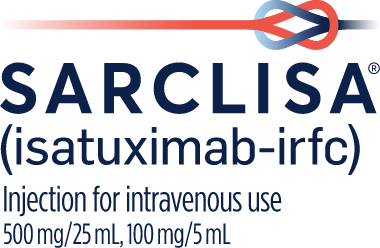FOR ADULTS WITH NEWLY DIAGNOSED MULTIPLE MYELOMA NOT ELIGIBLE FOR TRANSPLANT
Trial 3: SARCLISA + Velcade®, Revlimid®, and dexamethasone (VRd) helped more patients live progression free vs VRd alone
Trial 3 measured progression-free survival, which means the length of time patients lived without having their multiple myeloma getting worse.
At 5 years (60 months)
SARCLISA + VRd
63 %
of patients lived without their multiple myeloma getting worse
VS
VRd alone
45 %
of patients lived without their multiple myeloma getting worse
At a median follow-up of 60 months, 63% (167 out of 265 patients) lived progression free with SARCLISA + Velcade (bortezomib), Revlimid (lenalidomide), and dexamethasone (VRd) vs 45% (81 out of 181 patients) treated with VRd alone.
SARCLISA + Velcade, Revlimid, and dexamethasone (VRd): A clinical trial that included 446 patients with newly diagnosed multiple myeloma who were not eligible for autologous stem cell transplant (ASCT). The clinical trial was conducted in 2 phases: an induction phase and a continuous phase. Of the 446 patients in the trial, 265 patients received SARCLISA + VRd and 181 patients received VRd alone in the induction phase. Following the induction phase, Velcade was discontinued for both treatment arms, and patients went on to receive SARCLISA + Revlimid and dexamethasone (Rd) or Rd alone in the continuous phase.
The trial compared how long patients lived progression free and how patients responded to treatment.
Trial 3: More patients achieved a complete response or better with SARCLISA + VRd vs VRd alone
Trial 3 also measured complete response or better, which means that a patient's multiple myeloma improved with treatment to the point where there are no signs of myeloma cells detected by certain tests.
achieved a complete response or better with SARCLISA + VRd
At a median follow-up of 60 months, 75% (198 out of 265 patients) treated with SARCLISA + VRd achieved complete response or better vs 64% (116 out of 181 patients) treated with VRd alone.
More patients achieved both MRD negativity and complete response or better with SARCLISA + VRd vs VRd alone
Trial 3 also measured minimal (or measurable) residual disease, or MRD, which refers to the small number of myeloma cells that may survive in the body after treatment. MRD testing is highly sensitive and can detect 1 myeloma cell in 100,000 healthy cells, and can help your doctor understand how you are responding to treatment.
At 5 years (60 months)
SARCLISA + VRd
55 %
VS
VRd alone
41 %
At a median follow-up of 60 months, in patients who achieved complete response or better, 55% (147 out of 265 patients) also achieved MRD negativity vs 41% (74 out of 181 patients) treated with VRd alone.
SARCLISA is a targeted
immunotherapy that works
together with your immune system.


